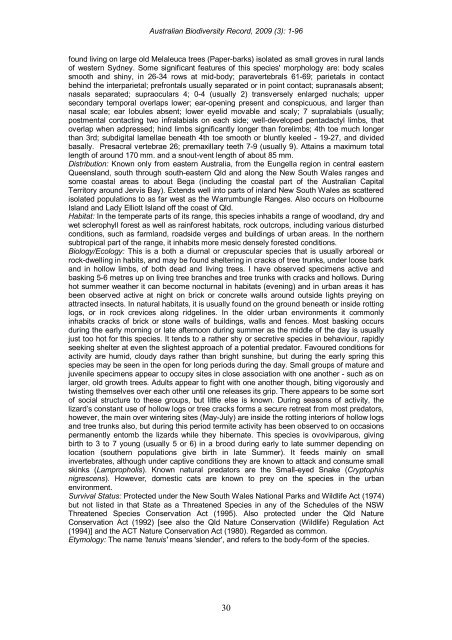AUSTRALIAN BIODIVERSITY RECORD - Calodema
AUSTRALIAN BIODIVERSITY RECORD - Calodema
AUSTRALIAN BIODIVERSITY RECORD - Calodema
Create successful ePaper yourself
Turn your PDF publications into a flip-book with our unique Google optimized e-Paper software.
Australian Biodiversity Record, 2009 (3): 1-96<br />
found living on large old Melaleuca trees (Paper-barks) isolated as small groves in rural lands<br />
of western Sydney. Some significant features of this species' morphology are: body scales<br />
smooth and shiny, in 26-34 rows at mid-body; paravertebrals 61-69; parietals in contact<br />
behind the interparietal; prefrontals usually separated or in point contact; supranasals absent;<br />
nasals separated; supraoculars 4; 0-4 (usually 2) transversely enlarged nuchals; upper<br />
secondary temporal overlaps lower; ear-opening present and conspicuous, and larger than<br />
nasal scale; ear lobules absent; lower eyelid movable and scaly; 7 supralabials (usually;<br />
postmental contacting two infralabials on each side; well-developed pentadactyl limbs, that<br />
overlap when adpressed; hind limbs significantly longer than forelimbs; 4th toe much longer<br />
than 3rd; subdigital lamellae beneath 4th toe smooth or bluntly keeled - 19-27, and divided<br />
basally. Presacral vertebrae 26; premaxillary teeth 7-9 (usually 9). Attains a maximum total<br />
length of around 170 mm. and a snout-vent length of about 85 mm.<br />
Distribution: Known only from eastern Australia, from the Eungella region in central eastern<br />
Queensland, south through south-eastern Qld and along the New South Wales ranges and<br />
some coastal areas to about Bega (including the coastal part of the Australian Capital<br />
Territory around Jervis Bay). Extends well into parts of inland New South Wales as scattered<br />
isolated populations to as far west as the Warrumbungle Ranges. Also occurs on Holbourne<br />
Island and Lady Elliott Island off the coast of Qld.<br />
Habitat: In the temperate parts of its range, this species inhabits a range of woodland, dry and<br />
wet sclerophyll forest as well as rainforest habitats, rock outcrops, including various disturbed<br />
conditions, such as farmland, roadside verges and buildings of urban areas. In the northern<br />
subtropical part of the range, it inhabits more mesic densely forested conditions.<br />
Biology/Ecology: This is a both a diurnal or crepuscular species that is usually arboreal or<br />
rock-dwelling in habits, and may be found sheltering in cracks of tree trunks, under loose bark<br />
and in hollow limbs, of both dead and living trees. I have observed specimens active and<br />
basking 5-6 metres up on living tree branches and tree trunks with cracks and hollows. During<br />
hot summer weather it can become nocturnal in habitats (evening) and in urban areas it has<br />
been observed active at night on brick or concrete walls around outside lights preying on<br />
attracted insects. In natural habitats, it is usually found on the ground beneath or inside rotting<br />
logs, or in rock crevices along ridgelines. In the older urban environments it commonly<br />
inhabits cracks of brick or stone walls of buildings, walls and fences. Most basking occurs<br />
during the early morning or late afternoon during summer as the middle of the day is usually<br />
just too hot for this species. It tends to a rather shy or secretive species in behaviour, rapidly<br />
seeking shelter at even the slightest approach of a potential predator. Favoured conditions for<br />
activity are humid, cloudy days rather than bright sunshine, but during the early spring this<br />
species may be seen in the open for long periods during the day. Small groups of mature and<br />
juvenile specimens appear to occupy sites in close association with one another - such as on<br />
larger, old growth trees. Adults appear to fight with one another though, biting vigorously and<br />
twisting themselves over each other until one releases its grip. There appears to be some sort<br />
of social structure to these groups, but little else is known. During seasons of activity, the<br />
lizard’s constant use of hollow logs or tree cracks forms a secure retreat from most predators,<br />
however, the main over wintering sites (May-July) are inside the rotting interiors of hollow logs<br />
and tree trunks also, but during this period termite activity has been observed to on occasions<br />
permanently entomb the lizards while they hibernate. This species is ovoviviparous, giving<br />
birth to 3 to 7 young (usually 5 or 6) in a brood during early to late summer depending on<br />
location (southern populations give birth in late Summer). It feeds mainly on small<br />
invertebrates, although under captive conditions they are known to attack and consume small<br />
skinks (Lampropholis). Known natural predators are the Small-eyed Snake (Cryptophis<br />
nigrescens). However, domestic cats are known to prey on the species in the urban<br />
environment.<br />
Survival Status: Protected under the New South Wales National Parks and Wildlife Act (1974)<br />
but not listed in that State as a Threatened Species in any of the Schedules of the NSW<br />
Threatened Species Conservation Act (1995). Also protected under the Qld Nature<br />
Conservation Act (1992) [see also the Qld Nature Conservation (Wildlife) Regulation Act<br />
(1994)] and the ACT Nature Conservation Act (1980). Regarded as common.<br />
Etymology: The name 'tenuis' means 'slender', and refers to the body-form of the species.<br />
30

















